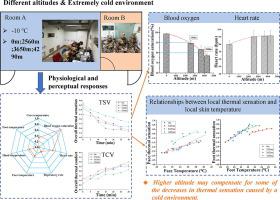Energy and Buildings ( IF 6.6 ) Pub Date : 2021-02-27 , DOI: 10.1016/j.enbuild.2021.110844 Zhuqiang Hu , Jiansong Wu , Lin Yang , Yin Gu , Hongfei Ren

|
An increasing number of people are living or working at high altitudes, which are often accompanied by cold environments. High altitude and cold exposure often result in physiological, perceptual and biochemical changes, thus affecting work efficiency and even human health. This study created different altitude conditions of 0 m, 2560 m, 3650 m, and 4290 m with an ambient temperature of -10 ℃ in a climate chamber. Six health subjects were recruited and human physiological and perceptual responses during this experiment were continuously investigated, involving objective parameters such as core temperature, local skin temperature, blood oxygen saturation, heart rate, respiratory rate and subjective parameters such as overall and local thermal sensation, overall and local thermal comfort. The statistical analysis showed that blood oxygen saturation is the most sensitive parameter to altitude changes, which is consistent with previous studies and shows a close relationship with altitude. All of the mean local skin temperatures in the face, hands and feet throughout the experimental period were lowest at 0 m altitude. The overall thermal sensation decreased by 2.83 units at 0 m, whereas it decreased by only 2.00 units at an altitude of 4290 m. The local thermal sensation correlated well with the local skin temperature (R2 > 0.8) at 0 m, 2560 m and 3650 m. At an altitude of 4290 m, the local thermal sensations of the face, hands and feet were close to 0 (neutral). These findings indicate that higher altitude can compensate for some of the decreases in thermal sensation caused by a cold environment.
中文翻译:

在极端寒冷的环境中暴露于不同高度的生理和知觉响应
越来越多的人在高海拔地区生活或工作,而高海拔地区通常都伴随着寒冷的环境。高原和寒冷暴露通常会导致生理,知觉和生化方面的变化,从而影响工作效率,甚至影响人类健康。这项研究在气候箱中创建了0 m,2560 m,3650 m和4290 m的不同海拔条件,环境温度为-10℃。招募了六名健康受试者,并不断研究了该实验过程中的人体生理和知觉反应,涉及诸如核心温度,局部皮肤温度,血氧饱和度,心率,呼吸频率的客观参数以及诸如整体和局部热感觉等主观参数,整体和局部的热舒适性。统计分析表明,血氧饱和度是对海拔变化最敏感的参数,这与以前的研究一致,并且与海拔高度密切相关。在整个实验期间,脸部,手部和脚部的所有平均局部皮肤温度在0 m高度最低。总体热感在0 m处下降了2.83个单位,而在4290 m高度仅下降了2.00个单位。局部热感与局部皮肤温度(R 在0 m处有83个单位,而在4290 m处仅减少了2.00个单位。局部热感与局部皮肤温度(R 在0 m处有83个单位,而在4290 m处仅减少了2.00个单位。局部热感与局部皮肤温度(R2 > 0.8)在0 m,2560 m和3650 m处。在4290 m的高度上,面部,手和脚的局部热感接近0(中性)。这些发现表明,较高的海拔可以补偿由于寒冷环境引起的一些热感觉下降。











































 京公网安备 11010802027423号
京公网安备 11010802027423号